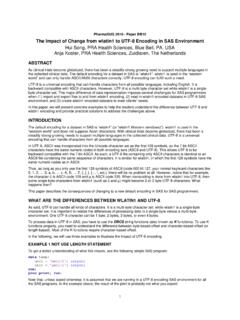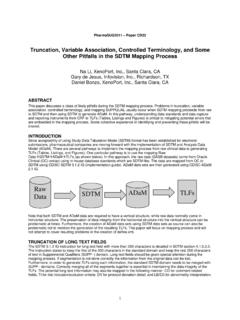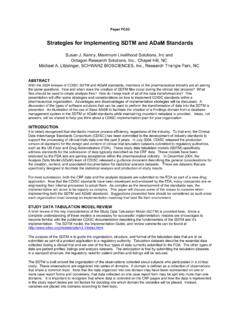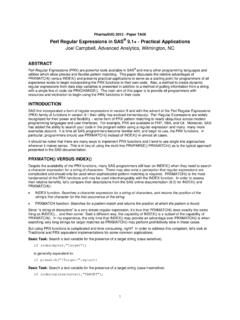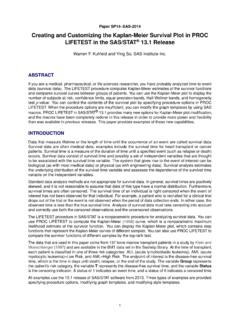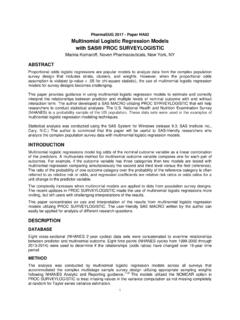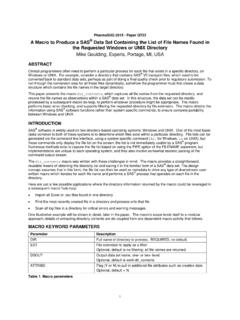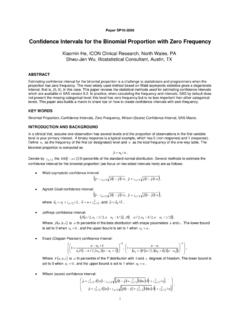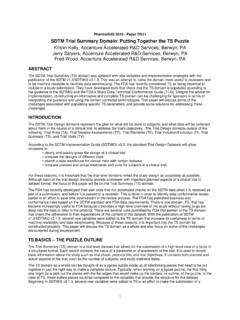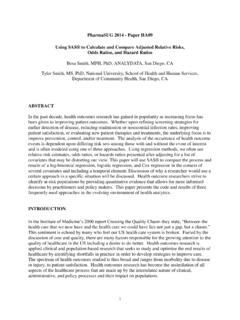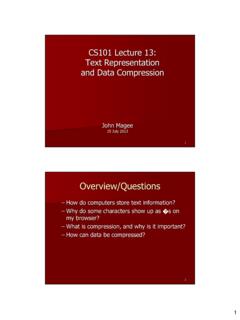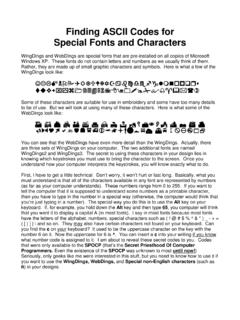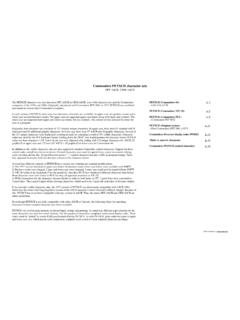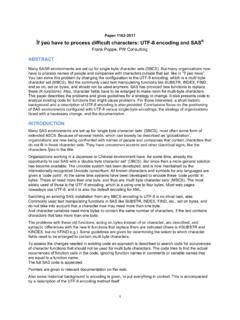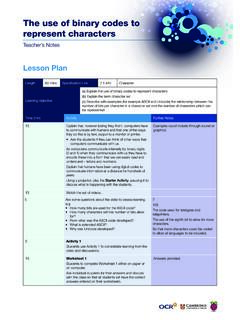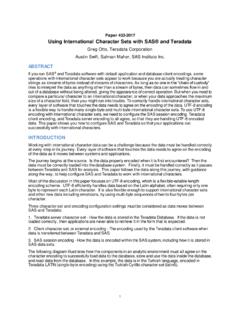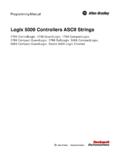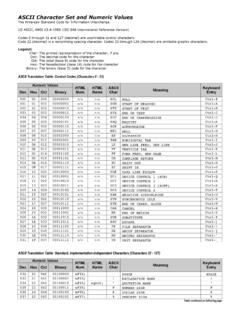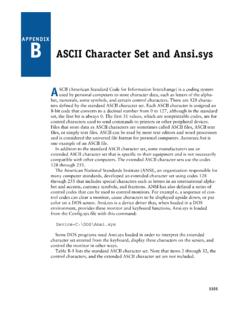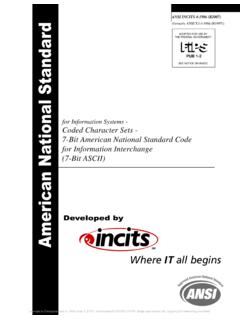Transcription of UTF What? A Guide to Using UTF-8 Encoded Data …
1 1 PharmaSUG 2016 - Paper BB16 UTF What? A Guide to Using UTF-8 Encoded data in a SDTM Submission Michael Stackhouse, Chiltern, Cary, North Carolina ABSTRACT The acronyms SBCS, DBCS, or MBCS ( single, double, and multi-byte character sets) mean nothing to most statistical programmers. Many do not concern themselves with the encoding of their data , but what happens when data encoding causes SAS to error? The errors produced by SAS and some common workarounds for the issue may not answer important questions about what the issue was or how it was handled. Though encoding issues can apply to any set of data , this presentation will be geared towards an SDTM submission. Additionally, a common origin of the transcoding error is UTF-8 Encoded source data , whose use is rising in popularity by database providers, making it likely that this error will continue appear with greater frequency.
2 Therefore, the ultimate goal of this paper will be to provide guidance on how to obtain fully compliant SDTM data with the intent of submission to the FDA from source datasets provided natively in UTF-8 encoding. Among other topics, in this paper we first explore UTF-8 encoding, explaining what it is and why it is. Furthermore, we demonstrate how to identify the issues not explained by SAS, and recommend best practices dependent on the situation at hand. Lastly, we review some preventative checks that may be added into SAS code to identify downstream impacts early on. By the end of this paper, the audience should have a clear vision of how to proceed when their clinical database is Using separate encoding from their native system. INTRODUCTION character data is stored as a series of bytes. Bytes are made up of bits (binary digits), which are the smallest unit of data in a computer, containing a value of 1 or 0.
3 Typically, bytes consist of eight bits. Bytes can be organized into different sequences to represent a number between 0 and 255. Encoding is how a computer interprets and represents the values within data . data encoding will consist of a character set, which is the list of characters capable of being represented by the encoding. To connect the byte level data to the desired characters, a coded character set maps the number represented by a byte to its corresponding character . One distinguishing factor of data encoding types is the number of bytes used to store the characters. Encoding may be a Single Byte character Set (SBCS), Double Byte character Set (DBCS) or Multi Byte character Set (MBCS). A standard SBCS would be LATIN1 Encoding. This encoding consists of the standard ascii character set, which includes upper and lower case English characters, the digits 0 through 9, and some special and control characters ( $, *, carriage returns, etc.)
4 LATIN1 also includes the extended ascii character set which includes additional characters used in most Western European languages ( , ) and additional special characters ( , ). But the characters within the extended ascii character set are not all inclusive. The focus is on Western European languages. What about Eastern languages? What about Asian languages, Cyrillic, These written languages consist of thousands of characters, and one byte is not enough. This is where a DBCS or a MBCS come into use. Universal character set Transformation Format-8-bit ( UTF-8 ) encoding attempts to represent all characters in all languages. It is capable of representing more than 120,000 characters covering 129 scripts and multiple symbol sets. While the first 128 characters of the ascii code range may be represented by one byte, other characters within UTF-8 may require up to 4 bytes to be represented (Dutton, 2015).
5 WHERE YOU ARE AND WHERE YOU NEED TO GO The SAS session encoding is the encoding that is used by SAS while it works with data . The encoding of a permanent dataset being read into SAS may differ. In these cases, the dataset being read in must be transcoded into the session encoding for SAS to work with it. In many cases, SAS can do this itself by Using Cross-Environment data Access (CEDA). Adjusting your session encoding differs between programming environments, but in order to determine your session encoding, you can simply use PROC OPTIONS: proc options option=encoding; run; UTF What? A Guide to Using UTF-8 Encoded data in a SDTM Submission continued 2 This will output a message to your log, telling you what encoding you SAS session is Using . ENCODING= UTF-8 Specifies the default character -set encoding for the SAS session. Output 1.
6 Log output generated by PROC OPTIONS. As for checking the encoding of a permanent dataset, this information is available when Using PROC CONTENTS on the permanent dataset: proc contents data = ; run; The encoding of the dataset is displayed within the PROC CONTENTS output. The CONTENTS Procedure data Set Name Observations 0 Member Type data Variables 0 Engine V9 Indexes 0 Created Sunday, February 21, 2016 10:01:45 PM Observation Length 0 Last Modified Sunday, February 21, 2016 10:01:45 PM Deleted Observations Protection Compressed NO data Set Type Sorted NO Label data Representation LINUX_IA64 Encoding UTF-8 Unicode ( UTF-8 ) Output 2.
7 Output from PROC CONTENTS While the FDA does not explicitly state requirements for data encoding, there are related standards that must be followed. Per the technical conformance Guide , Variable names, as well as variable and dataset labels should include American Standard Code for Information Interchange ( ascii ) text codes only (Rui, 2016). As for the contents of the data itself, the agency requires only the English language and expects sponsors to remove or convert non- ascii characters collected in research before submission ( Food and Drug Administration, 2015). This is an important requirement of which to be aware, as the use of free text fields in UTF-8 Encoded source data has high potential to capture non- ascii characters. Also, for reasons on which this paper will elaborate, it can be assumed that the extended- ascii character set is included in the list of character that should be removed or converted.
8 WHERE THE PROBLEMS COME FROM IN YOUR data Taking into consideration the extensiveness of the UTF-8 character set, it is fairly clear how characters from other languages can slip into your data , depending on where the data were collected, investigators and subjects, etc. Unfortunately, even some fairly common characters can still cause issues when transcoding. These character will most likely come from free text fields, and include characters such as left or right quotes ( or versus "), long dashes ( versus - ), and other characters that a windows environment might automatically correct for you. Venturing into the extended- ascii character set is where issues will start to present themselves. To understand why, we need to look at how SAS transcodes the data . HOW SAS TRANSCODES AND WHY ERRORS HAPPEN In many situations in which SAS needs to transcode, SAS does the work for you.
9 This is because of Cross-Environment data Access (CEDA). CEDA allows SAS to do the work behind the scenes. Assuming no issues are encountered, you are left with a simple note in the log. NOTE: data file is in a format that is native to another host, or the file encoding does not match the session encoding. Cross Environment data Access will be used, which might require additional CPU resources and might reduce performance. Output 1. Log message showing note generated by CEDA. In other situations, you may not be so lucky. SAS may be unable to transcode the data . To make matters worse, the log errors generated by SAS do not explicitly state where or why SAS encountered the issue. UTF What? A Guide to Using UTF-8 Encoded data in a SDTM Submission continued 3 ERROR: Some character data was lost during transcoding in the dataset Either the data contains characters that are not representable in the new encoding or truncation occurred during transcoding.
10 Output 2. Log message showing the error generated by SAS when it is unable to transcode. Though the error does not Guide you to the issue, it gives some context as to why the issue could be happening. Transcoding errors can happen in SAS for two reasons: 1. The dataset being read into SAS has a character that is not representable in the session encoding. 2. Truncation occurred during transcoding. The first potential issue has a much clearer explanation than the second. As mentioned before, UTF-8 encoding supports more than 120,000 characters. This is vastly greater than the 256 characters handled by LATIN1. If there is no character to transcode to, then the character cannot be transcoded. For example, if in a UTF-8 Encoded dataset, the Greek character exists then LATIN1 has no compatible conversion for this, and thus SAS forces the error as the conversion was not successful.
